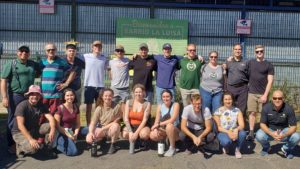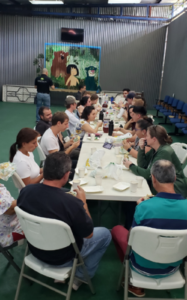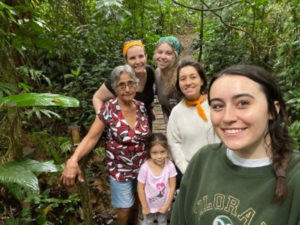Katie Bond is a construction management graduate student. In her own words, this articles describes her experience as part of the short-term study abroad course Sustainable Buildings: Introduction to Sustainable Design and Construction – Costa Rica (CON 450). The program is led by Rodolfo Valdes-Vasquez and Mehmet E. Ozbek, both faculty members in the Department of Construction Management at Colorado State University. From Jan. 2-13, 2023, the students visited various locations, including San José, La Fortuna, and Turrialba.

The Sustainable Buildings Study Abroad was an educational adventure. Though students learned so much during lectures, discussions, and presentations, the most memorable experiences came from visiting three local communities.
Barrio La Luisa, San José
While in San José, the students met with the La Luisa Community Association to learn about their history and goals. A few years ago, this community had been contacted by a developer who was building condos that overlooked their community. The developer was having trouble selling the condos because people didn’t like the view when looking down at the community.

The developer offered to pay the residents of Barrio La Luisa to paint their roofs, to improve the view for the condo residents. The residents of Barrio La Luisa were organized and didn’t see any value for themselves in painting their roofs. Instead, they asked the developer to build a playground for their children. When the developer built the playground, trust was established, and the residents of La Luisa painted a mural on their roofs to improve the view for the condo residents.
Unfortunately, the developer stopped communicating with the Barrio La Luisa residents after they painted their roofs. When the mural needed to be repaired the residents chose not to do it, as the roof aesthetic has no impact on them.
Two important lessons were learned from this experience: 1) The community members were organized and knew what they needed. The developer could get what they wanted only after finding a win-win with the community. 2) Maintaining relationships is very important. The deterioration of the roof mural maintenance is representative of the deterioration of the relationship between the developer and Barrio La Luisa.
Rancho Margot, La Fortuna
Rancho Margot is a self-sustaining off-grid community in the rain forest, which is a 45-minute drive from the nearest town. They produce their electricity using hydropower from the nearby rivers. The

same mountain rivers provide clean drinking water for the community. They produce more electricity than they need, though they do not use batteries for storage because they do not consider batteries to be eco-friendly.
Their food comes from their livestock and gardens. Compost from the livestock manure is used to fertilize the gardens. They have a biogas digester for heating a hot tub. The buildings have green roofs that grow naturally from birds dropping seeds. These green roofs provide natural insulation and reduce the sound of rain on a metal roof. They use fermented microorganisms for pest control and odor control around the livestock. It’s a nearly complete circular economy.

for pest and odor control at Rancho Margot.
One important aspect of living off-grid is maintaining a connection to the local community. Rancho Margot buys necessary supplies from the closest town and, in turn, is able to sell their products there, too. They make soap, cheese, and raise some pigs to sell.
In addition, they needed a reliable way for local students to attend secondary school in their remote part of Costa Rica. Rancho Margot started by driving the local kids to and from La Fortuna and, eventually, sponsored a bus. Today, after several years, they have worked with the locals in El Castillo to have their own school and Rancho Margot provides teachers for weekly English classes. This aligns with the owner’s goal to hire and educate Costa Ricans. It also supports a broader view of sustainability.
La Argentina, Guácimo
Near the end of the study abroad program, the group had the opportunity to spend two nights at homes in La Argentina, a farming community that is partially sustained by eco-tourism. Bond stayed with three other students at the home of Doña Rosa, a kind, energetic woman in her eighties.
In this community, the students learned the value of community organization, partnering with the local university, and, unfortunately, saw first-hand the aging rural farmer population that isn’t being replaced by younger generations.

La Argentina is in a remote part of Costa Rica. In the early 2000’s, they organized to offer their homes for visiting students. They partnered with EARTH University and other agencies facilitating student home stays. Doña Rosa also has a gathering space for serving a meal for large groups coming through the area. Many of the farms offer something in addition to a homestay.
The partnership with EARTH extends beyond bringing students for homestays. They also partner with the farmers to find sustainable solutions on the farms. As an example, EARTH University students installed biogas digesters in several farms so they could use the manure from their livestock to generate heat for cooking.
The final lesson learned in La Argentina is related to the aging population of farmers in rural areas, who are not being replaced by younger generations. Everyone in the group stayed in a home where the host was over 70 years old. In many cases, their children are not interested in farming and have jobs in urban areas. This trend is disheartening, though consistent with rural populations elsewhere.
In summary, visiting these three communities in Costa Rica taught the importance of communities organizing to support themselves in a sustainable fashion. Barrio La Luisa and La Argentina were strong because they worked as a group, toward the betterment of all members.
The value of partnership was another lesson learned. All three communities had developed mutually beneficial local partnerships. Finally, the students learned about closed loop (circular) economic systems, particularly in Rancho Margot and La Argentina, where most “waste” can be used as a resource within the community.
About the Sustainable Buildings class

The short-term study abroad course Sustainable Buildings: Introduction to Sustainable Design and Construction – Costa Rica (CON 450) takes students through the country, focusing on the principles of sustainable design and construction, energy, healthy building, natural resources, and other environmental issues. CSU students work with local students to learn about the best sustainable practices through renowned international examples.
During this year’s program, students went on field trips, learned from local guest speakers, visited the CATIE campus, and stayed with host families.
The program received 2019 Award for Excellence in Education Abroad Curriculum Design by the Forum on Education Abroad.
For information on future offerings and how to apply, see the course information on the CSU Education Abroad website. Priority application deadline: May 1, 2023.
Office of International Programs Contact: Nikki LeBlanc, nikki.leblanc@colostate.edu, 970-491-4967
The Department of Construction Management is part of CSU’s College of Health and Human Sciences.